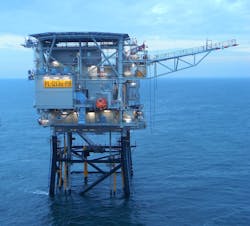Gasunie joins North Sea integrated energy project
Offshore staff
LONDON – Gasunie, which maintains gas transport and storage infrastructure in the Netherlands and northern Germany, has agreed to join Neptune Energy in the PosHYdon pilot project.
PosHYdon, designed to integrate energy from offshore wind, offshore gas, and offshore hydrogen in the Dutch North Sea, will involve the installation of a hydrogen-producing plant on Neptune’s Q13a platform. It is a joint initiative between Nexstep, the Dutch association for decommissioning and re-use, and TNO, the Netherlands organization for applied scientific research.
Other members of the PosHYdon consortium are NOGAT and Noordgastransport, owners of large gas trunkline systems serving Dutch offshore fields.
Electricity generated by offshore wind turbines will be used to power the hydrogen plant on the fully-electrified Q13a platform, 13 km (9.1 mi) offshore Scheveningen, converting seawater into de-mineralized water, and then into hydrogen via electrolysis.
The pilot will provide experience of integrating working energy systems at sea and the production of hydrogen in an offshore environment.
Other partners in Q13a-A platform are EBN and TAQA Offshore.
Lex de Groot, managing director of Neptune Energy in the Netherlands, said: “Gasunie is already working hard to accelerate the energy transition, including several hydrogen pilots on land, and has the necessary knowledge and experience with electrolysis in-house…
“The pipelines and infrastructure at sea of NOGAT and Noordgastransport are already suitable for hydrogen and that is good news as offshore production will continue to be crucial to meet Dutch energy demand.
“The Netherlands is in a special position as, in addition to an extensive gas infrastructure network, we can harvest large amounts of wind energy in the North Sea, quantities that are also important internationally. The wind energy can be used to generate hydrogen, then transport onshore along with natural gas via the existing large pipelines of NOGAT and Noordgastransport for customers in industry, the transport sector and for Dutch homes.”
04/20/2020
